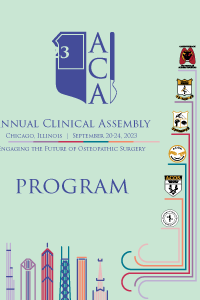Back
Introduction/Purpose: Salpingectomy and Tubal Ligation are commonly performed procedures for permanent contraception in women. Salpingectomy has been suggested to reduce the risk of ovarian cancer, but its comparative operative and perioperative risks have not been well established. The objective of this study is to compare peri and postoperative complications of minimally invasive tubal ligation versus salpingectomy for permanent contraception.
Methods or Case Description: We conducted a retrospective cohort study of women who underwent Salpingectomy or Tubal Ligation for permanent contraception between 2018 and 2021 using data from the American College of Surgeons (ACS) National Surgical Quality Improvement Program (NSQIP) database. The primary outcomes were intraoperative or postoperative transfusion, operation time, and length of hospital stay. Secondary outcomes were perioperative and postoperative complications.
Outcomes: A retrospective cohort study was conducted using the NSQIP database from 2008 to 2021 using CPT codes for laparoscopic salpingectomy and laparoscopic tubal ligation as the inclusion criteria. A total of 49,445 patients were included. Of the total, 91.6% underwent salpingectomy and 8.4% received tubal ligation. Salpingectomy had a higher risk of operative and postoperative complications compared to tubal ligation. Salpingectomy had a higher risk of intraoperative or postoperative transfusion, longer operation time, longer hospital stay, readmission, and unplanned reoperation. In addition, occurrences of organ space surgical site infection, urinary tract infection, and sepsis were significantly higher in the salpingectomy group compared to the tubal ligation group.
Conclusion: Tubal ligation and salpingectomy are both safe and effective procedures for permanent contraception, however, salpingectomy is more likely to be associated with peri and postoperative complications. These findings may help guide clinical decision-making when selecting the optimal permanent contraception method for women.
ACOS 2023 Annual Clinical Assembly
Urological Surgery
Podium Presentations - Urological Surgery
Peri and Postoperative Complications of Minimally Invasive Tubal Ligation versus Salpingectomy for Permanent Contraception
Thursday, September 21, 2023
3:30 PM – 3:40 PM CT
Location: Avenue Ballroom, 4th Floor

Kimberly C. Lince, M.S., Student Doctor (she/her/hers)
Student Doctor
University of the Incarnate WordDisclosure information not submitted.
Member Speaker(s)
Disclosure(s):
Vaishnavi J. Patel: No financial relationships to disclose
Learning Objectives:
- List and compare the peri and postoperative complications associated with minimally invasive tubal ligation and salpingectomy procedures for permanent contraception.
- Analyze patient-specific risk factors that contribute to complications following both tubal ligation and salpingectomy surgeries, utilizing evidence-based data.
- Synthesize research findings to draw evidence-based conclusions about the relative complication rates between minimally invasive tubal ligation and salpingectomy, facilitating informed medical decision-making.
Methods or Case Description: We conducted a retrospective cohort study of women who underwent Salpingectomy or Tubal Ligation for permanent contraception between 2018 and 2021 using data from the American College of Surgeons (ACS) National Surgical Quality Improvement Program (NSQIP) database. The primary outcomes were intraoperative or postoperative transfusion, operation time, and length of hospital stay. Secondary outcomes were perioperative and postoperative complications.
Outcomes: A retrospective cohort study was conducted using the NSQIP database from 2008 to 2021 using CPT codes for laparoscopic salpingectomy and laparoscopic tubal ligation as the inclusion criteria. A total of 49,445 patients were included. Of the total, 91.6% underwent salpingectomy and 8.4% received tubal ligation. Salpingectomy had a higher risk of operative and postoperative complications compared to tubal ligation. Salpingectomy had a higher risk of intraoperative or postoperative transfusion, longer operation time, longer hospital stay, readmission, and unplanned reoperation. In addition, occurrences of organ space surgical site infection, urinary tract infection, and sepsis were significantly higher in the salpingectomy group compared to the tubal ligation group.
Conclusion: Tubal ligation and salpingectomy are both safe and effective procedures for permanent contraception, however, salpingectomy is more likely to be associated with peri and postoperative complications. These findings may help guide clinical decision-making when selecting the optimal permanent contraception method for women.

